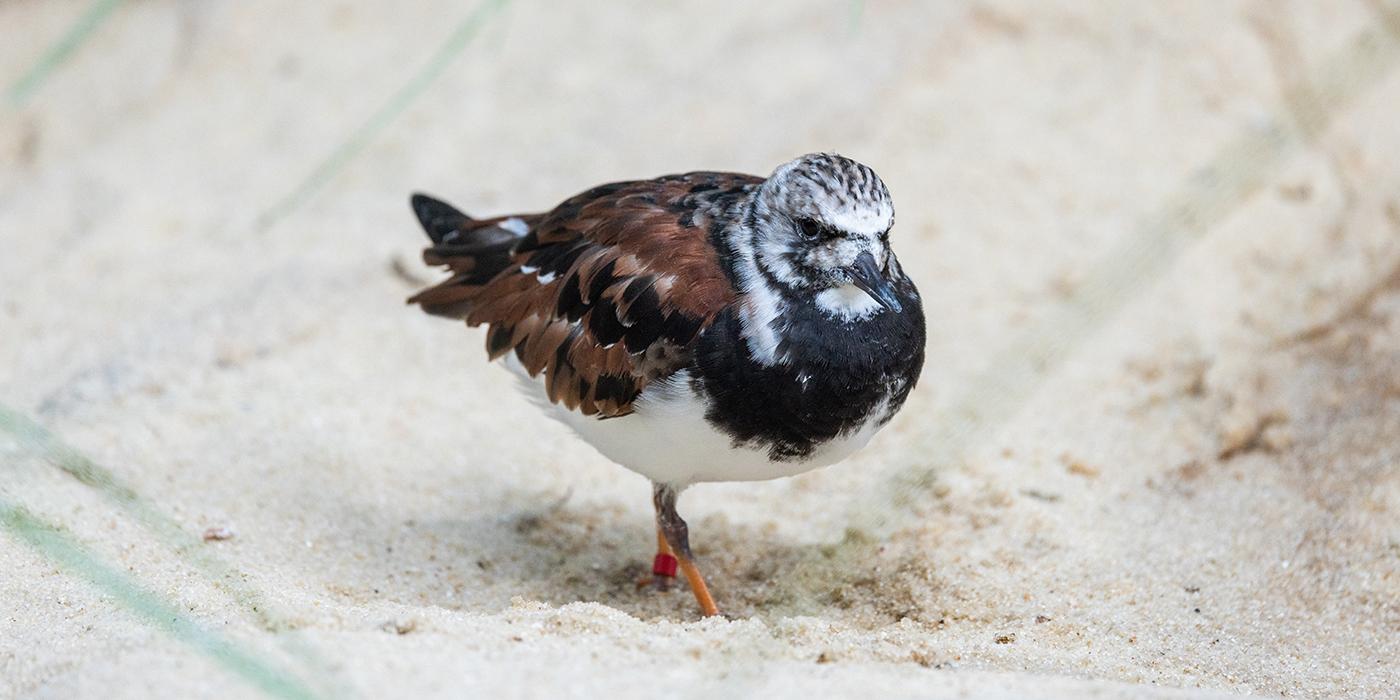Physical Description
Ruddy turnstones show a striking color pattern in flight: a white stripe down the back, black tail stripe, white rump, and white stripe down the wings. All ruddy turnstones have orange legs, which are brighter during the breeding season.
Breeding males have black-and-white markings on their head and throat with a rufous and black calico cat-like pattern on their back. Breeding females are paler than males. Nonbreeding adults have a brown feather pattern. Juveniles look similar to nonbreeding birds but have rusty edges on their feathers.
Turnstones have a sturdy, slightly upturned bill that helps them flip over stones, shells and seaweed while looking for food. Their short, curved toenails and slightly spiny feet allow them to move around safely on slippery rock surfaces. They rely on their short legs and a low center of gravity to stay balanced.
Size
Adults are 6.3–8.3 inches (16-21 centimeters) long with a wingspan of 19–22 inches (50-57 centimeters).
Native Habitat
Ruddy turnstones live on rocky shorelines and tundra across the high Arctic during the breeding season. During the migration and wintering seasons, they can be found in a variety of habitats, including coastal and freshwater shorelines, rocky and sandy beaches, mudflats and deltas. Ruddy turnstones breed on the high Arctic tundra of North America and Eurasia, and winter along the coasts of North and South America, Eurasia, Africa and Australia.
Lifespan
The oldest recorded ruddy turnstone lived to be 19 years old, but their average lifespan is estimated at six to seven years.
Communication
Ruddy turnstones use a series of calls and visual displays to communicate. For example, clicking sounds are used to distract predators, "pri pri pri" calls are used to call in young, and "kitititit" calls are a type of alarm or contact call they make towards other turnstones.
Food/Eating Habits
Ruddy turnstones forage for food by using their upturned bills to flip over rocks, shells, pebbles, etc. During the breeding season, they feed primarily on larval flies and midges, but will also eat spiders, beetles, bees, wasps and other insects. They are also known to pick at dead fish and mammals that wash up on shore before insects emerge in the summer.
Their diet is more varied during nonbreeding season, and includes small crustaceans, mollusks and bird eggs.
Sleep Habits
They gather in large groups to sleep and rest.
Social Structure
They are fairly aggressive and territorial during the breeding season but will form small to large groups and mix with other shorebirds during the nonbreeding season.
Reproduction and Development
They are monogamous and often return to the same breeding site to mate with the same individual year after year. Males and females both perform noisy ground and aerial displays to strengthen their bond. The female chooses the nesting site within the male's territory and builds a shallow nest, or scrape, in the ground with her body. She may also use small bits of vegetation to line the bottom of the scrape. The scrapes are often made in wet areas near vegetation and out of the wind, but they can also be found on bare gravel or in sand barrens.
Females will lay two to five eggs, which are olive green to cream in color with brown speckles. The incubation period is 21-24 days and both parents take turns sitting on the nest.
Newly hatched chicks are mobile and able to feed themselves. Both parents take care of the young, but the female will depart before the chicks can fly. The male will stay until the chicks fledge at 19 to 21 days old.
Conservation Efforts
Ruddy turnstones are a relatively common shorebird, but the remoteness of their breeding grounds makes it difficult to estimate their population trends. One study estimated a 77% decline in the number of turnstones around Delaware Bay from 1988 to 2007.
Major threats include habitat loss, plastic pollution, lack of availability of food and climate change.
Help this Species
Practice ecotourism by being an advocate for the environment when you’re on vacation. During your travels, support, visit or volunteer with organizations that protect wildlife. Shop smart too! Avoid buying products made from animals, which could support poaching and the illegal wildlife trade.
Be a responsible cat owner, and keep cats indoors or under restraint when outside. Never release animals that have been kept as pets into the wild.
Organize or attend a stream, river, lake or other waterway cleanup in your area to preserve aquatic habitats for local species.
Avoid single-use plastics, such as plastic bottles, bags and utensils. Choosing reusable options instead can help reduce plastic pollution.
Never release balloons. Animals often mistake them for food or become entangled in their strings. Looking for an alternative? Try blowing bubbles instead!
Be a smart consumer. Choose products made with sustainable ingredients, such as Smithsonian certified Bird Friendly coffees, which support farmers striving to limit their impact on wildlife and habitat.
Smithsonian's National Zoo and Conservation Biology Institute. (n.d.). Ruddy turnstone. Retrieved October 17, 2025, from https://nationalzoo.si.edu/animals/ruddy-turnstone
Animal News

7 Spooktacular Animal Facts for Halloween ›

Meet the Orangutans Living at the Smithsonian’s National Zoo ›

